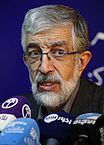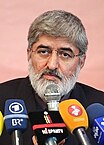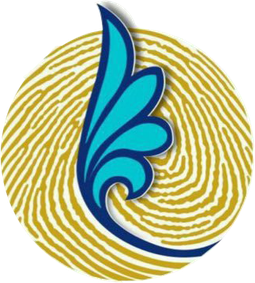| |||||||||||||||||||||||||||||||||||||
All 290 seats to the Islamic Consultative Assembly 146 seats are needed for a majority | |||||||||||||||||||||||||||||||||||||
|---|---|---|---|---|---|---|---|---|---|---|---|---|---|---|---|---|---|---|---|---|---|---|---|---|---|---|---|---|---|---|---|---|---|---|---|---|---|
| Turnout | 62% (first round) [1] 59% (second round) [2] | ||||||||||||||||||||||||||||||||||||
| |||||||||||||||||||||||||||||||||||||

| |||||||||||||||||||||||||||||||||||||
| |||||||||||||||||||||||||||||||||||||
Parliamentary elections were held in Iran on 26 February 2016 to elect members of the Islamic Consultative Assembly for all seats in the 10th parliament in the Islamic Republic era and the 34th since the Persian Constitutional Revolution. A second round was held on 29 April 2016 for some constituencies where candidates failed to obtain the required minimum 25 percent of votes cast. [4] The elected MPs will serve from May 28, 2016 to May 27, 2020.

Iran, also called Persia, and officially the Islamic Republic of Iran, is a country in Western Asia. With over 81 million inhabitants, Iran is the world's 18th most populous country. Comprising a land area of 1,648,195 km2 (636,372 sq mi), it is the second largest country in the Middle East and the 17th largest in the world. Iran is bordered to the northwest by Armenia and the Republic of Azerbaijan, to the north by the Caspian Sea, to the northeast by Turkmenistan, to the east by Afghanistan and Pakistan, to the south by the Persian Gulf and the Gulf of Oman, and to the west by Turkey and Iraq. The country's central location in Eurasia and Western Asia, and its proximity to the Strait of Hormuz, give it geostrategic importance. Tehran is the country's capital and largest city, as well as its leading economic and cultural center.

The Islamic Consultative Assembly, also called the Iranian Parliament, the Iranian Majles, is the national legislative body of Iran. The Parliament currently has 290 representatives, changed from the previous 272 seats since the 18 February 2000 election. The most recent election took place on 26 February 2016 and the new parliament was opened on 28 May 2016.
The 10th Islamic Consultative Assembly is the 34th and current Parliament of Iran that commenced on 28 May 2016 following the legislative elections on 26 February and 29 April 2016.
Contents
- Electoral system
- Qualifications
- Campaigns and voting
- Opinion polls
- MPs elected
- Results
- See also
- References
- External links
The election was held as part of a general election which also elected members of the Assembly of Experts. [5] This election was the first time that both bodies were elected simultaneously.

The Assembly of Experts —also translated as the Assembly of Experts of the Leadership or as the Council of Experts— is the deliberative body empowered to designate and dismiss the Supreme Leader of Iran. However all directly-elected members after the vetting process by the Guardian Council still have to be approved by the Supreme Leader of Iran before gaining membership to the Assembly of Experts.
There were 54,915,024 registered voters (in Iran, the voting age is 18). More than 12,000 people filed to run for office. [6] Nomination of 5,200 of candidates, mostly Reformists, [6] were rejected by the Guardian Council and 612 individuals withdrew.
A voting age is a minimum age established by law that a person must attain before they become eligible to vote in a public election. Today, the most common voting age is 18 years; however, voting ages as low as 16 and as high as 25 currently exist. Most countries have set a minimum voting age, often set in their constitution. In a number of countries voting is compulsory for those eligible to vote, while in most it is optional.

The Guardian Council of the Constitution is an appointed and constitutionally mandated 12-member council that wields considerable power and influence in the Islamic Republic of Iran.
















